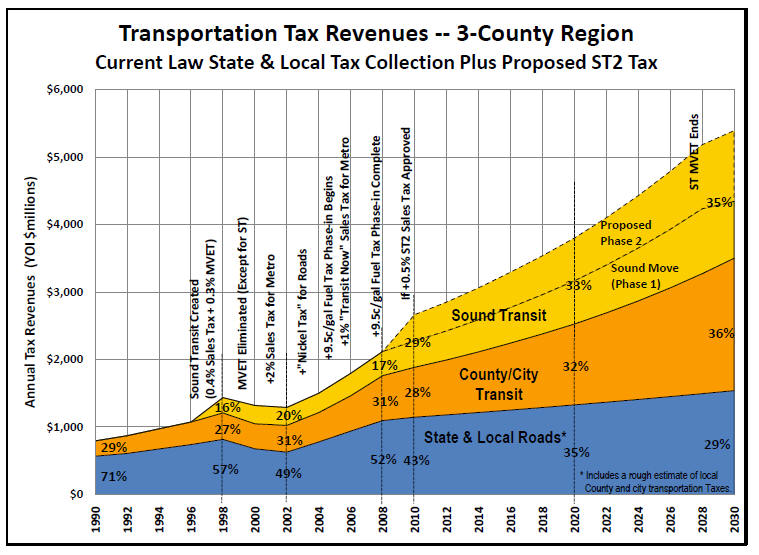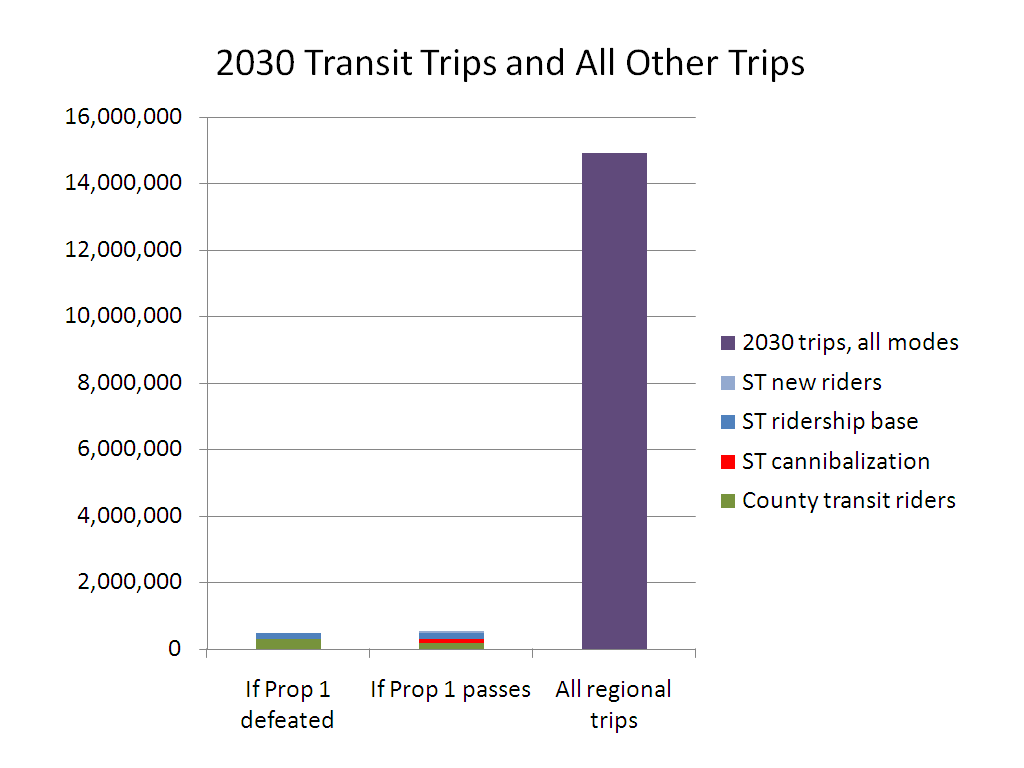![]()
by John Niles
![]()
![]()
As we've said elsewhere, the 2008 Prop 1 victory in King, Pierce, and Snohomish Counties on November 4, 2008 amounts to more than a doubling of Sound Transit's local transportation sales tax. A new way of looking at this tax growth is shown below.
Jim MacIsaac, a Bellevue-based professional transportation engineer and contributor to Public Interest Transportation Forum, has prepared a graphic that shows the total transportation taxes of the three county region projected out into the future:

As can be seen, in 2008, public transit taxes split 52% for state and local roads, and 48% for public transit, including both Sound Transit and the county-level public transit systems.
Prop 1 passed in November, and Sound Transit taxes will double. Along with sales tax revenues from growing population and economic activity, the total public transit share of taxes is expected to grow to 71%, with a 29% share remaining for the roads on which most public transit buses move.
This growth in the share of regional tax resources going to transit would be more acceptable if the projections of transit market share were expected by planners to grow proportionally. This is not the case.
The Mass Transit Plan of Sound Transit projects a very modest growth of 13% in overall annual transit ridership as a result of Prop 1.
According to Sound Transit, the 2030 daily transit ridership picture on all of its services, both express buses and rail would be 195,000 per day without Prop 1, and 358,000 per day with the additional expenditure of the Prop 1 taxes. This represents a growth in just the Sound Transit part of the regional transit system of 84%.
Most of the growth in Sound Transit ridership represents the redirection of riders using today's extensive bus service onto rail service on a few corridors, a phenomenon known as cannibalization. This replacement effect is seen by the forecast of total regional transit ridership forecast at 482,000 per day without Prop 1, and 544,000 per day if Prop 1 passes, a growth of 62,000, or just 13%, shown in the graph below in the right hand bar at the top. The cannibalization of 101,000 riders going from local transit to Sound Transit is shown as the red segment of the right hand bar.

The 13% growth in total transit ridership compared to an 84% growth in Sound Transit's ridership results in proportionally more customers on Sound Transit and fewer on the buses of King County Metro, Pierce Transit, and Community Transit. Sound Transit's calculation is that the fraction of transit ridership on its services in 2030 would have been 40% if Prop 1 failed, but will be 65% now that Prop 1 has passed.
This growth in Sound Transit ridership is alleged to result in greater efficiency in the transit system, with a lower cost per rider because a train can carry more riders than a bus. However, there is no evidence that larger capacity vehicles make up for the extraordinary new costs of maintaining a network of tracks and stations. At the same time, the transit customer experience will include more standing on trains instead of sitting on buses, and more transfers from buses to trains in the average morning transit journey, because of the simple fact that the number of train stations is limited. Feeder buses provide the main form of access to light rail train stations.
The 195,000 daily ridership base shown on both bars in the above graphic is what Sound Transit reports it would have achieved even if Prop 1 had failed to pass. This ridership comes from the part of Sound Transit that is already fully funded with the taxes passed in 1996. As of early autumn 2008, just before the Prop 1 election, Sound Transit was carrying about 50,000 riders per day on the services it has opened since 1996. At least a decade beyond 2008 is needed for Sound Transit to reach the 195,000 base that it says will be accomplished with taxes authorized under the 1996 Sound Move voter approval.
Click here for slightly revised PDF version of foregoing analysis provided to Sound Transit Phase 2 Expert Review Panel in October 2008.
The final picture needed is the graph below illustrating the place of transit in the overall mobility forecast for 2030. Puget Sound Regional Council forecasts that 14,900,000 regional trips per day will occur in 2030, shown by the tall bar on the right hand side of the graph below, set proportionally to the same two bars on the left as the two bars in the previous graph above.

Sound Transit makes very little difference to regional mobility. More on this point is covered in an op-ed I wrote for the Federal Way News of August 12, 2008 prior to the Prop 1 approval, titled "New Sound Transit plan would not matter much."
![]()
Click here for an estimated schedule of $107 billion in Prop 1 tax collections
![]()
Public Interest Transportation Forum home page.
![]()
Last modified:
February 07, 2011